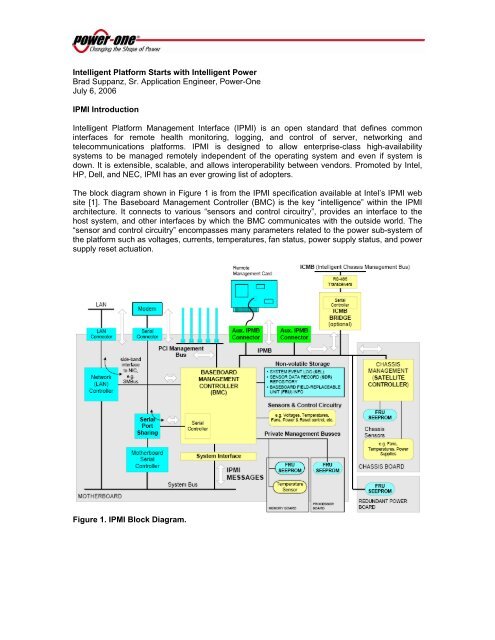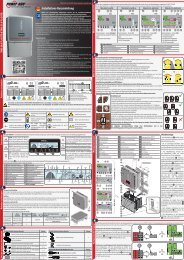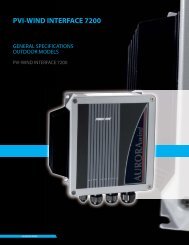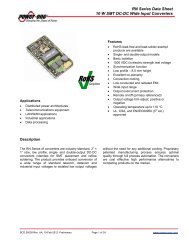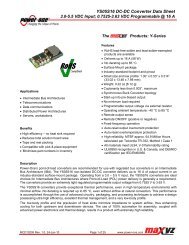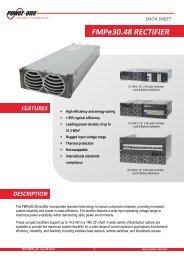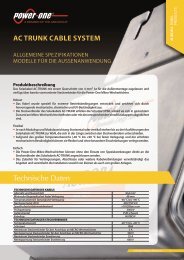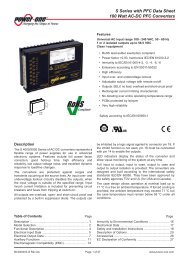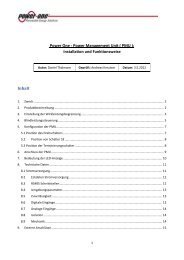Intelligent Platform Starts with Intelligent Power - Power-One
Intelligent Platform Starts with Intelligent Power - Power-One
Intelligent Platform Starts with Intelligent Power - Power-One
Create successful ePaper yourself
Turn your PDF publications into a flip-book with our unique Google optimized e-Paper software.
<strong>Intelligent</strong> <strong>Platform</strong> <strong>Starts</strong> <strong>with</strong> <strong>Intelligent</strong> <strong>Power</strong>Brad Suppanz, Sr. Application Engineer, <strong>Power</strong>-<strong>One</strong>July 6, 2006IPMI Introduction<strong>Intelligent</strong> <strong>Platform</strong> Management Interface (IPMI) is an open standard that defines commoninterfaces for remote health monitoring, logging, and control of server, networking andtelecommunications platforms. IPMI is designed to allow enterprise-class high-availabilitysystems to be managed remotely independent of the operating system and even if system isdown. It is extensible, scalable, and allows interoperability between vendors. Promoted by Intel,HP, Dell, and NEC, IPMI has an ever growing list of adopters.The block diagram shown in Figure 1 is from the IPMI specification available at Intel’s IPMI website [1]. The Baseboard Management Controller (BMC) is the key “intelligence” <strong>with</strong>in the IPMIarchitecture. It connects to various “sensors and control circuitry”, provides an interface to thehost system, and other interfaces by which the BMC communicates <strong>with</strong> the outside world. The“sensor and control circuitry” encompasses many parameters related to the power sub-system ofthe platform such as voltages, currents, temperatures, fan status, power supply status, and powersupply reset actuation.Figure 1. IPMI Block Diagram.
Z-<strong>One</strong> ® Digital <strong>Power</strong>The Z-<strong>One</strong> ® family of products from <strong>Power</strong>-<strong>One</strong> includes digital Point-Of-Load converters (POLs)and Digital <strong>Power</strong> Managers (DPMs) [2]. These products provide a complete hardware solutionfor implementing a Digital Intermediate Bus Architecture (IBA) power system that includesmultiple Point-Of-Load converter modules. As shown in Figure 2, a DPM can connect to up to 32POLs via the Sync/Data line and can connect to the host system or PC-based Graphical UserInterface (GUI) via an I 2 C bus [3]. The I 2 C bus is used for programming, controlling, andmonitoring the Z-<strong>One</strong> ®system. Parameters such as output voltages, sequencing and tracking,and protections are all configurable via the GUI. Voltage, current, temperature, and statusmonitoring are available over the I 2 C bus as well. Monitoring and control of 4 auxiliary devicessuch as LDOs or VRMs is also supported.Figure 2. Z-<strong>One</strong> ® Digital <strong>Power</strong> System.The programmable features of the Z-<strong>One</strong> ®system allow one to easily implement the complexpower subsystem requirements found in modern server applications and the monitoring andcontrol features of the Z-<strong>One</strong> ® solution map nicely into the IPMI requirements. Thus Z-<strong>One</strong> ®products are an excellent choice as the foundation of an intelligent power sub-system thatsupports IPMI.While not required for basic operation, high-end Z-<strong>One</strong> ® applications can use a service processorto tap into the monitoring and control features while the system is operational. The serviceprocessor is typically an inexpensive microcontroller that is programmed to communicate <strong>with</strong> theDPM via I 2 C to issue the desired queries and commands, then format and transfer the results.In the scheme of IPMI, the service processor is the BMC which utilizes the I 2 C bus over which theIPMI message protocols are implemented. Once the IPMI protocols are used, the I 2 C bus isdubbed an <strong>Intelligent</strong> <strong>Platform</strong> Management Bus (IPMB). In addition to supporting the IPMImessaging protocols, the IPMB is allowed to communicate <strong>with</strong> other non-IPMI devicessupporting their own I 2 C protocols. This makes the IPMB very flexible and supportive of devicessuch as I 2 C memory and sensors. The DPM of a Z-<strong>One</strong> ® system can be thought of as providingan array of sensors and controls available via the I 2 C bus. With Z-<strong>One</strong> ® , monitoring and controlare included in the POLs and DPM whereas <strong>with</strong> analog power solutions, all the monitoring andcontrol circuitry has to be added externally.
Z-<strong>One</strong> ® IPMI SolutionFigure 3 shows a diagram of a Z-<strong>One</strong> ® based IPMI implementation. The Z-<strong>One</strong> ® DPM and POLsprovide the digital power sub-system hardware and support monitoring and control while the BMCimplements the standard IPMI messaging protocols and required external communicationinterfaces. The Z-<strong>One</strong> ® solution was designed to support a wide range of power applications andincludes native I 2 C commands to supports it’s programming and monitoring functions. The BMCessentially forms a bridge between the external communication buses and the DPM. The designis partitioned to take advantage of the features of Z-<strong>One</strong> ® while offloading the application specificmessage formatting and external communication tasks to the BMC which forms bridges to anyapplicable industry standard communication interface desired.Z-<strong>One</strong>IPMIDPM &POLsBMCLANProgrammableDigital <strong>Power</strong> Sub-System HardwareI 2 C Bus(IPMB)Monitoringand ControlIPMI MessagingProtocolsCommunicationInterfacesSerial/ SSTSystemBusPCIMBusFigure 3. IPMI Implementation Diagram.References[1] Intel IPMI web site:http://www.intel.com/design/servers/ipmi/index.htm[2] <strong>Power</strong>-<strong>One</strong>, Inc. Z-<strong>One</strong> ® web site:http://www.power-one.com/products/Z.html[3] Philips I 2 C web site:http://www.semiconductors.philips.com/products/interface_control/i2cI 2 C is a trademark of Philips Corporation.About the authorBrad Suppanz is a Sr. Applications Engineer at <strong>Power</strong>-<strong>One</strong>, holds a BSEL from Cal Poly SanLuis Obispo (1985), an MSEE from Cal State Northridge (1996), has been in the power industrysince 1985, and has been at <strong>Power</strong>-<strong>One</strong> since 2003.


